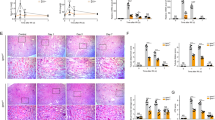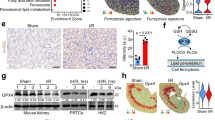Abstract
Background
Renal ischemia/reperfusion (I/R) leads to acute kidney injury and is associated with cell ferroptosis, an oxidative programmed cell death. This study aims to explore whether USP7 regulates ferroptosis in rat kidneys suffered I/R and the underlying mechanisms.
Methods
Human renal tubular epithelial cells HK-2 were treated with hypoxia/reoxygenation (H/R) to establish a cell model. The expression of ubiquitin specific peptidase 7 (USP7) in H/R-treated cells was determined. USP7 siRNA was transfected into H/R-treated cells, followed by the detection of cell proliferation, iron ion concentration, oxidative stress levels and glutathione peroxidase 4 (GPX4) and solute carrier family 7-member 11 (SLC7A11) protein levels. Western blotting and immunoprecipitation analyses were performed to detect the effects of USP7 on the ubiquitination of TANK-binding kinase 1 (TBK1) and DNA methyltransferase 1 (DNMT1). Then, H/R-treated cells were transfected with USP7 siRNA alone or together with TBK1 siRNA. Co-immunoprecipitation was used to detect binding relationship between TBK1 and FMRP translational regulator 1 (FMR1). The level of DNMT1 and methylation ratio of the FMR1 promoter region were determined with chromatin immunoprecipitation and methylation specific PCR assays, respectively. Furthermore, USP7 siRNA and FMR1 siRNA were transfected alone or together into H/R-treated cells, followed by the detection of cell functions. An I/R rat model was constructed to analyze the effects of USP7 on renal function in rats.
Results
USP7 was significantly upregulated in H/R-treated cells. USP7 interference markedly increased HK-2 cell proliferation and the protein levels of GPX4 and SLC7A11, restrained the iron ion concentration, and ameliorated oxidative stress. USP7 promoted TRIM27-mediated TBK1 ubiquitination and degradation. USP7 inhibition resulted in increased ubiquitination and decreased stability of DNMT1. USP7 was able to recruit DNMT1 to the FMR1 promoter region, which increased promoter methylation rates and suppressed FMR1 expression. TBK1 or FMR1 overexpression could reverse the effects of USP7 on cell functions. Inhibition of USP7 alleviated renal ischemia–reperfusion injury in rats.
Conclusions
USP7 inhibition attenuated I/R-induced renal injury by inhibiting ferroptosis through decreasing ubiquitination of TBK1 and promoting DNMT1-mediated methylation of FMR1.








Similar content being viewed by others
Data availability
The datasets used during the present study are available from the corresponding author on reasonable request.
Abbreviations
- I/R:
-
Renal ischemia/reperfusion
- H/R:
-
Hypoxia/reoxygenation
- GPX4:
-
Ubiquitin specific peptidase 7, glutathione peroxidases 4
- SLC7A11:
-
Solute carrier family 7 member 11
- TBK1:
-
TANK-binding kinase 1
- DNMT1:
-
DNA methyltransferase 1
- Co-IP:
-
Co-immunoprecipitation
- FMR1:
-
FMRP translational regulator 1
- ChIP:
-
Chromatin immunoprecipitation
- AKI:
-
Acute kidney injury
- RCD:
-
Regulated cell death
- HO-1:
-
Heme oxygenase-1
- NCOA4:
-
Nuclear receptor coactivator 4
- FTH1:
-
Ferritin light chain 1
- SAP:
-
Severe acute pancreatitis
- DUBs:
-
Deubiquitinating enzymes
- KD:
-
Kinase domain
- SDD:
-
Scaffold dimerization domain
- CCD2:
-
Coiled coil domain 2
- ULD:
-
Ubiquitin like domain
- PCNA:
-
Proliferating cell nuclear antigen
- PTMs:
-
Post-translational modifications
- HDACs:
-
Histone deacetylases
- USP2B:
-
Ubiquitin specific protease
- SD:
-
Sprague–Dawley
- Cr:
-
Serum creatinine
- BUN:
-
Blood urea nitrogen
- DMEM:
-
Dulbecco’s modified eagle medium
- FBS:
-
Fetal bovine serum
- SDS-PAGE:
-
Sodium dodecyl sulfate polyacrylamide gel electrophoresis
- PVDF:
-
Polyvinylidene difluoride
- Ub:
-
Ubiquitin
- HRP:
-
Horseradish peroxidase
- CCK-8:
-
Cell Counting Kit-8
- ChIP:
-
Chromatin immunoprecipitation assay
- ELISA:
-
Enzyme-linked immunosorbent assay
- SOD:
-
Superoxide dismutase
- MDA:
-
Malondialdehyde
- MSP:
-
Methylation-specific PCR
- CpG:
-
Cytosine-phosphate-guanine
- ICP-MS:
-
Inductively coupled plasma mass spectrometry
- SEM:
-
Standard error of mean
- rAAV:
-
Recombinant adeno-associated virus
- CKD:
-
Chronic kidney disease
References
Liang C, Zhang X, Yang M, Dong X. Recent progress in ferroptosis inducers for cancer therapy. Adv Mater (Deerfield Beach, Fla). 2019;31: e1904197.
Lu LQ, Tian J, Luo XJ, Peng J. Targeting the pathways of regulated necrosis: a potential strategy for alleviation of cardio-cerebrovascular injury. Cell Mol Life Sci: CMLS. 2021;78:63–78.
Tang S, Xiao X. Ferroptosis and kidney diseases. Int Urol Nephrol. 2020;52:497–503.
Ursini F, Maiorino M. Lipid peroxidation and ferroptosis: the role of GSH and GPx4. Free Radical Biol Med. 2020;152:175–85.
Fang X, Cai Z, Wang H, Han D, Cheng Q, Zhang P, et al. Loss of cardiac ferritin H facilitates cardiomyopathy via Slc7a11-mediated ferroptosis. Circ Res. 2020;127:486–501.
Borawski B, Malyszko J. Iron, ferroptosis, and new insights for prevention in acute kidney injury. Adv Med Sci. 2020;65:361–70.
Palazón-Riquelme P, Worboys JD, Green J, Valera A, Martín-Sánchez F, Pellegrini C, et al. USP7 and USP47 deubiquitinases regulate NLRP3 inflammasome activation. EMBO Rep. 2018;19:e44766.
Ji L, Lu B, Zamponi R, Charlat O, Aversa R, Yang Z, et al. USP7 inhibits Wnt/β-catenin signaling through promoting stabilization of Axin. Nat Commun. 2019;10:4184.
Qi SM, Cheng G, Cheng XD, Xu Z, Xu B, Zhang WD, et al. Targeting USP7-mediated deubiquitination of MDM2/MDMX-p53 pathway for cancer therapy: are we there yet? Front Cell Dev Biol. 2020;8:233.
Lv P, Li C, Wang M, Ren J, Zhang Y, Fu G. TANK-binding kinase 1 alleviates myocardial ischemia/reperfusion injury through regulating apoptotic pathway. Biochem Biophys Res Commun. 2020;528:574–9.
Han H, Yang X, Pandiyan K, Liang G. Synergistic re-activation of epigenetically silenced genes by combinatorial inhibition of DNMTs and LSD1 in cancer cells. PLoS ONE. 2013;8: e75136.
Harada T, Ohguchi H, Grondin Y, Kikuchi S, Sagawa M, Tai YT, et al. HDAC3 regulates DNMT1 expression in multiple myeloma: therapeutic implications. Leukemia. 2017;31:2670–7.
Vervaet BA, Moonen L, Godderis L, Poels K, D’Haese PC. Untargeted DNA-demethylation therapy neither prevents nor attenuates ischemia-reperfusion-induced renal fibrosis. Nephron. 2017;137:124–36.
Fu AQ, Genereux DP, Stöger R, Burden AF, Laird CD, Stephens M. Statistical inference of in vivo properties of human DNA methyltransferases from double-stranded methylation patterns. PLoS ONE. 2012;7: e32225.
Zhang F, Zhang B, Tang R, Jiang H, Ji Z, Chen Y, et al. The occurrence of lupus nephritis is regulated by USP7-mediated JMJD3 stabilization. Immunol Lett. 2021;235:41–50.
Yan G, Liu N, Tian J, Fu Y, Wei W, Zou J, et al. Deubiquitylation and stabilization of ARMC5 by ubiquitin-specific processing protease 7 (USP7) are critical for RCC proliferation. J Cell Mol Med. 2021;25:3149–59.
Tang LJ, Zhou YJ, Xiong XM, Li NS, Zhang JJ, Luo XJ, et al. Ubiquitin-specific protease 7 promotes ferroptosis via activation of the p53/TfR1 pathway in the rat hearts after ischemia/reperfusion. Free Radical Biol Med. 2021;162:339–52.
Kajarabille N, Latunde-Dada GO. Programmed cell-death by ferroptosis: antioxidants as mitigators. Int J Mol Sci. 2019;20:4968.
Cai J, Chen HY, Peng SJ, Meng JL, Wang Y, Zhou Y, et al. USP7-TRIM27 axis negatively modulates antiviral type I IFN signaling. FASEB J. 2018;32:5238–49.
Vershkov D, Yilmaz A, Yanuka O, Nielsen AL, Benvenisty N. Genome-wide screening for genes involved in the epigenetic basis of fragile X syndrome. Stem Cell Rep. 2022;17:1048–58.
Friedmann Angeli JP, Schneider M, Proneth B, Tyurina YY, Tyurin VA, Hammond VJ, et al. Inactivation of the ferroptosis regulator Gpx4 triggers acute renal failure in mice. Nat Cell Biol. 2014;16:1180–91.
Tang LJ, Zhou YJ, Xiong XM, Li NS, Zhang JJ, Luo XJ, et al. Ubiquitin-specific protease 7 promotes ferroptosis via activation of the p53/TfR1 pathway in the rat hearts after ischemia/reperfusion. Free Radical Biol Med. 2020;162:339–52.
Zhang L, Zhao X, Zhang M, Zhao W, Gao C. Ubiquitin-specific protease 2b negatively regulates IFN-β production and antiviral activity by targeting TANK-binding kinase 1. J Immunol (Baltimore Md: 1950). 2014;193:2230–7.
Cui J, Li Y, Zhu L, Liu D, Songyang Z, Wang HY, et al. NLRP4 negatively regulates type I interferon signaling by targeting the kinase TBK1 for degradation via the ubiquitin ligase DTX4. Nat Immunol. 2012;13:387–95.
Zheng Q, Hou J, Zhou Y, Yang Y, Xie B, Cao X. Siglec1 suppresses antiviral innate immune response by inducing TBK1 degradation via the ubiquitin ligase TRIM27. Cell Res. 2015;25:1121–36.
Du Z, Song J, Wang Y, Zhao Y, Guda K, Yang S, et al. DNMT1 stability is regulated by proteins coordinating deubiquitination and acetylation-driven ubiquitination. Sci Signal. 2010;3:ra80.
Shen W, Kuang P, Wang B, Zeng Q, Chen C, Lin X. Genetic polymorphisms of LPCAT1, CHPT1 and PCYT1B and risk of neonatal respiratory distress syndrome among a Chinese Han population. Pediatr Neonatol. 2020;61:318–24.
Yamaguchi L, Nishiyama A, Misaki T, Johmura Y, Ueda J, Arita K, et al. Usp7-dependent histone H3 deubiquitylation regulates maintenance of DNA methylation. Sci Rep. 2017;7:55.
Li M, Liu S, Chen H, Zhou X, Zhou J, Zhou S, et al. N-benzylpiperidinol derivatives as novel USP7 inhibitors: Structure-activity relationships and X-ray crystallographic studies. Eur J Med Chem. 2020;199: 112279.
Cheng J, Yang H, Fang J, Ma L, Gong R, Wang P, et al. Molecular mechanism for USP7-mediated DNMT1 stabilization by acetylation. Nat Commun. 2015;6:7023.
Felle M, Joppien S, Németh A, Diermeier S, Thalhammer V, Dobner T, et al. The USP7/Dnmt1 complex stimulates the DNA methylation activity of Dnmt1 and regulates the stability of UHRF1. Nucleic Acids Res. 2011;39:8355–65.
Qin W, Leonhardt H, Spada F. Usp7 and Uhrf1 control ubiquitination and stability of the maintenance DNA methyltransferase Dnmt1. J Cell Biochem. 2011;112:439–44.
Vershkov D, Fainstein N, Suissa S, Golan-Lev T, Ben-Hur T, Benvenisty N. FMR1 reactivating treatments in fragile X iPSC-derived neural progenitors in vitro and in vivo. Cell Rep. 2019;26:2531-2539.e4.
Bao J, Ye C, Zheng Z, Zhou Z. Fmr1 protects cardiomyocytes against lipopolysaccharide-induced myocardial injury. Exp Ther Med. 2018;16:1825–33.
Zhao Y, Ding C, Xue W, Ding X, Zheng J, Gao Y, et al. Genome-wide DNA methylation analysis in renal ischemia reperfusion injury. Gene. 2017;610:32–43.
Huang N, Tan L, Xue Z, Cang J, Wang H. Reduction of DNA hydroxymethylation in the mouse kidney insulted by ischemia reperfusion. Biochem Biophys Res Commun. 2012;422:697–702.
Talvio K, Kanninen KM, White AR, Koistinaho J, Castrén ML. Increased iron content in the heart of the Fmr1 knockout mouse. Biometals. 2021;34:947–54.
Rogers H, Ariza J, Monterrubio A, Hagerman P, Martínez-Cerdeño V. Cerebellar mild iron accumulation in a subset of FMR1 premutation carriers with FXTAS. Cerebellum (London, England). 2016;15:641–4.
Author information
Authors and Affiliations
Contributions
YL: designed this study and wrote the manuscript. BD: performed the experimental work. XL: provided the majority of statistical analysis as well as provided the figures and tables for the manuscript. JZ, CD, HX and WX: collected a large amount of data for the data set. All authors read and approved the final manuscript.
Corresponding author
Ethics declarations
Conflict of interest
The authors declare that they have no competing interests.
Ethical approval and consent to participate
This research was approved by the Medical Ethics Committee of the Xi’an Jiaotong University (No. XJTULAC2021-1461).
Consent for publication
Consent for publication was obtained from each author.
Additional information
Responsible Editor: John Di Battista.
Publisher's Note
Springer Nature remains neutral with regard to jurisdictional claims in published maps and institutional affiliations.
Supplementary Information
Below is the link to the electronic supplementary material.
Rights and permissions
Springer Nature or its licensor (e.g. a society or other partner) holds exclusive rights to this article under a publishing agreement with the author(s) or other rightsholder(s); author self-archiving of the accepted manuscript version of this article is solely governed by the terms of such publishing agreement and applicable law.
About this article
Cite this article
Dong, B., Ding, C., Xiang, H. et al. USP7 accelerates FMR1-mediated ferroptosis by facilitating TBK1 ubiquitination and DNMT1 deubiquitination after renal ischemia–reperfusion injury. Inflamm. Res. 71, 1519–1533 (2022). https://doi.org/10.1007/s00011-022-01648-1
Received:
Revised:
Accepted:
Published:
Issue Date:
DOI: https://doi.org/10.1007/s00011-022-01648-1




